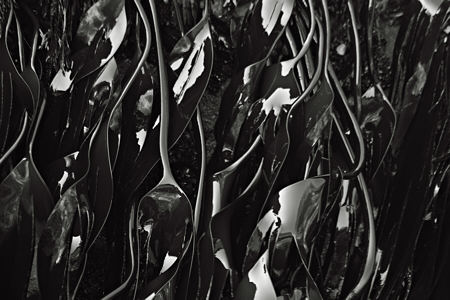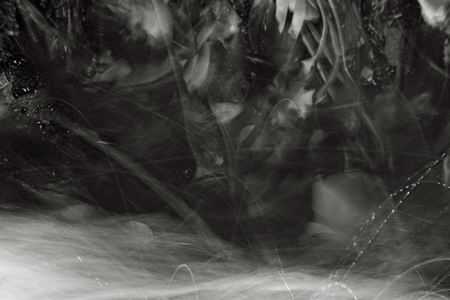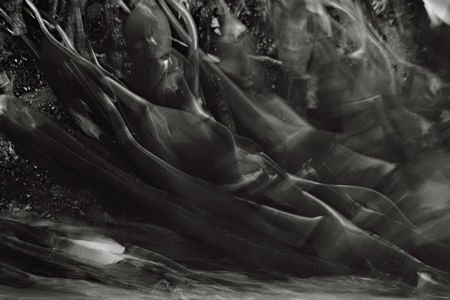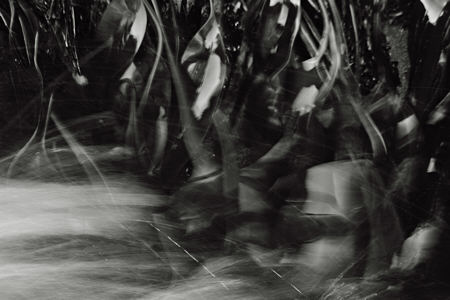
Most of my photography in Newfoundland was done within a few meters of the sea. I rediscovered there some of the rock and water themes I’ve pursued closer to home, though with important differences. For example, rocks are more likely shaped by the surf, and are as often wet as dry. New waterfalls are born every time a wave rides over a rock in the tidal zone. But the most interesting difference was the presence of living subjects at the rock/water interface, and of these, my favorite was seaweed.

Unfortunately, I only had a few minutes to spend with the kelp I discovered after scrambling down the cliff at the B&B (The Cliffhouse in southern Avalon–highly recommended). Attached to a boulder that was probably covered at high tide, the strands were exposed, but were carried back and forth by the surging forward and streaming back of each passing wave. The smooth, wet surfaces were gloriously reflective, so much so that I had to confine myself to a patch in shadow. I immediately fell in love with the motion effects at a slow shutter speed (1/4 to 1/2 second). I set up the camera and repeated the same shot, varying the timing with respect to the waves. I was there for eight minutes, time for only a couple dozen chances.



These are good examples of photographs with a strong uncontrolled, random component. I find great pleasure in discovering afterwards the shapes and compositions that have been captured. But I had to arrange the kelp myself (assuming that were possible), I’d be at a loss. Of course, photographing a plant lying on the sand also involves chance arrangement, if there’s no re-arranging. But the chance then is all in the past: at the time of capture, you know what you’re going to get.

I surmise that one aspect of the appeal of these photographs—if they have any—is that the viewer can share the same pleasure of discovering transient forms created by a patently random process. Why should this be? Is it just our ingrained search for order and meaning amid chaos?
I wonder if there’s a similar motivation for other artists who rely on elements that are uncontrolled or poorly controlled, as in Richard Serra’s Splash Pieces or Pollock’s drips. Do you deliberately try to lose control of some aspects of your art?


Beautiful.
This could be converted into a nice lesson for art students.
What a difference between the second picture and the rest.
In the second picture, the live plant looks like a steel sculpture.
D,
Thank you.
todd,
I’m intrigued by your comment. What aspects do you think would be most interesting or useful for students? Or just take it as an example of doing a study of a subject?
Birgit,
Yes, the softening of edges when the seaweed is moving gives a dramatically different feeling. When still it is like a black mirror (if wet). The fourth image shows a transition from almost still at the top to moving at the bottom. That’s one thing I was after; I’ll see whether I have more along those lines.
Your welcome.
More than ever, I feel this work captures how intrigued you are by the world around you. The experience feels spontaneous and simple and less about art.
Steve:
Surely eight minutes well spent.
Surge along the rocky coast can be perpetually fascinating – especially so along that stretch of the Eastern Seaboard. The shore line is diversely composed and has been sculpted both by water and ice. I’ve seen people camped out on a ledge with their coolers and chairs, ready to observe surf as others might birds, or a camp fire at night. There are spots at Acadia with which I have a deep connection.
Seaweed lives powerfully and there is a certain authority in its appearance. You caught some of the translation of a more chaotic energy in the water to a kind of vegetable dance. Patterns form in this ongoing behavior which can be sensed better than recorded. That’s why people sit out and meditate upon it.
Good question. I’m thinking about it.
Jay,
Yes, dance is something I thought of. The seaweed is powered by the waves, but is very different, obviously, in how it moves. “Translation” is a great way to put it: it’s like a different language, means of expression.
Steve:
Forgot to mention… While staring at my bleary face this morning my thoughts turned to Japanese gardens – your having been there – your search for the telling image – how almost every photo of a Japanese garden is panoramic – how the intrusive methods of the close-up, layering of elements etc. would create a different kind of meditation on the Japanese garden. I doubt if you could do this in Montana, but the Underwoods live near one of the best Japanese gardens in North America. Hint, hint, if you are there J&J.
Steve:
Japanese gardens trade in stillness. Are there any tidal pool gardens that you know of?
Jay,
I love Japanese gardens (and other things) and am constantly regretting that I was not active in photography while I lived there. I suspect you’re right in your generalization about most photographs being larger views. That’s the case with the two I own by William Corey, which are exquisite. (I was shocked to learn, checking his website, that he died earlier this year. It appears that at least some images will still be for sale, though perhaps not at the great print-of-the-month prices I purchased at.) It would make a great project to adopt a more close-up approach.
Your remarks anticipate another series I did in Newfoundland, also at the coast, which could be said to be about stillness and a Zen-like focus on simple objects (i.e. rocks). Perhaps paradoxically, the repetitive sounds of the surf do induce a tranquillity, and I was almost always alone at the shore.
Remnant tide pools seem especially still in contrast to the sea, and the idea of designing a tide garden is brilliant. Very challenging, as the configuration would be changing through the day, but great possibilities for using those cycles. It seems like a special discovery to find a series of pools slowly drawing down, each spilling into the next as the tide goes out.
Steve:
If you’ve been to the Monterey Aquarium you may have seen the tidal displays where one is situated almost at the bottom looking up. A tidal garden, if it were to share some commonality with a Japanese garden, would have to feature the view across while incorporating the view down and within. Makes me think of Point Lobos, by Pebble Beach, where a rocky headland offers views down into various inlets.
Actually, I haven’t Googled tide or tidal garden yet – will find that there are a bunch of them.
Steve:
Somebody has a garden dedicated to the Crimson Tide of Alabama. Otherwise, not so much.
A ritual sand castle would take the place of the raked rock garden.
Hello, anybody out there?
Jay,
I’ve searched also, and found no tide pool gardens. I can’t believe this huge gap. I’m sure there are artificial tide pool displays at various California and other locations, not to mention natural tide pools, but nobody seems to have thought of creating a garden that responds to the tides. If I ever acquire that coastal property, I’ll set things to rights.
Steve:
Just finished Stephenson’s novel “Anathem” so I have diverging narratives on my mind. What’s needed here is a path that includes a Jay, and maybe by choice, a Steve and many others, a milestone of which is a functioning tidal garden. This, while other narratives propagate other results.
I have started a post on Hoffmandu, my ragged little scrap of a nascent site, that deals with this garden concept. The whole thing puts me in mind of a blind man trying to hug the Queen Mary.
Designing a tidal garden would be a fascinating enterprise. Aside from the artistic aspects, which include being able to address time and change on a daily scale, I like the engineering challenge of making the dynamics of flowing water entirely dependent on lunar power.